Hopi
| Total population | |
|---|---|
| 18,327 (2010)[1] | |
| Languages | |
| Hopi, English | |
| Related ethnic groups | |
| Zuni, Navajo people, Pueblo peoples |

The Hopi are a Native American tribe, who primarily live on the 2,531.773 sq mi (6,557.26 km2) Hopi Reservation in northeastern Arizona. As of 2010, there were 19,327 Hopi in the United States, according to the 2010 census.[1] The Hopi language is one of 30 in the Uto-Aztecan language family. The majority of Hopi people are enrolled in the Hopi Tribe of Arizona but some are enrolled in the Colorado River Indian Tribes.
When first encountered by the Spanish in the 16th century, the Hopi and the surrounding cultures were referred to as Pueblo people, because they lived in villages (pueblos in the Spanish language). The Hopi are descended from the Ancient Pueblo Peoples (Hopi: Hisatsinom or Navajo: Anasazi) who constructed large apartment-house complexes in northeastern Arizona, northwestern New Mexico, and southwestern Colorado. They lived along the Mogollon Rim, especially from the 12th–14th century, when they abandoned their large villages.
The name Hopi is a shortened form of their autonym, Hopituh Shi-nu-mu ("The Peaceful People" or "Peaceful Little Ones").[2] The Hopi Dictionary[3] gives the primary meaning of the word "Hopi" as: "behaving one, one who is mannered, civilized, peaceable, polite, who adheres to the Hopi way." In the past, Hopi sometimes used the term "Hopi" and its cognates to refer to the Pueblo peoples in general, in contrast to other, more warlike tribes.[4]
Hopi is a concept deeply rooted in the culture's religion, spirituality, and its view of morality and ethics. To be Hopi is to strive toward this concept, which involves a state of total reverence and respect for all things, to be at peace with these things, and to live in accordance with the instructions of Maasaw, the Creator or Caretaker of Earth. The Hopi observe their traditional ceremonies for the benefit of the entire world.
Traditionally, Hopi are organized into matrilineal clans. When a man marries, the children from the relationship are members of his wife's clan. These clan organizations extend across all villages. Children are named by the women of the father's clan. On the twentieth day of a baby's life, the women of the paternal clan gather, each woman bringing a name and a gift for the child. In some cases where many relatives would attend, a child could be given over forty names, for example. The child's parents generally decide the name to be used from these names. Current practice is to either use a non-Hopi or English name or the parent's chosen Hopi name. A person may also change the name upon initiation into one of the religious societies, such as the Kachina society, or with a major life event.
The Hopi have always viewed their land as sacred. Agriculture is a very important part of their culture, and their villages are spread out across the northern part of Arizona. The Hopi and the Navajo did not have a conception of land being bounded and divided. They lived on the land that their ancestors did. On December 16, 1882 President Arthur passed an executive order creating a reservation for the Hopi. It was much smaller than the Navajo reservation, which was the largest in the country.[5]
On October 24, 1936 the Hopi people ratified a Constitution. That Constitution created a unicameral government where all powers are vested in a Tribal Council. While there is an executive branch (tribal chairman and vice chairman) and judicial branch, their powers are limited under the Hopi Constitution. The traditional powers and authority of the Hopi Villages was preserved in the 1936 Constitution.[6]
Today, the Hopi Reservation is entirely surrounded by the much larger Navajo Reservation. The two nations used to share the Navajo–Hopi Joint Use Area, but this was a source of conflict. The partition of this area, commonly known as Big Mountain, by Acts of Congress in 1974 and 1996, has also resulted in long-term controversy.[7][8][9]
Hopi History
The Hopi are one of many Native American cultures in the Southwestern United States. When first encountered by the Spanish in the 16th century, these cultures were referred to as Pueblo people because they lived in villages (pueblos in the Spanish language). The Hopi are descended from the Ancient Pueblo Peoples (Hopi: Hisatsinom or Navajo: Anasazi) who constructed large apartment-house complexes in northeastern Arizona, northwestern New Mexico, and southwestern Colorado. They lived along the Mogollon Rim, especially from the 12th–14th century, when they abandoned their large villages. No researchers have been able to determine the reason, although it is likely that a drying of water sources would have forced the people away.
Oraibi
Old Oraibi is one of four original Hopi villages, and one of the oldest continuously inhabited villages within the territory of the United States. In the 1540s the village was recorded as having 1,500–3,000 residents.[5]
Early European contact, 1540–1680
The first recorded European contact with the Hopi was by the Spanish in A.D 1540. Spanish General Francisco Vásquez de Coronado went to North America to explore the land. While at the Zuni villages, he learned of the Hopi tribe. Coronado dispatched Pedro de Tovar and other members of their party to find the Hopi villages.[10] The Spanish wrote that the first Hopi village they visited was Awatovi. They noted that there were about 16,000 Hopi and Zuni people.[5] A few years later, the Spanish explorer García López de Cárdenas investigated the Rio Grande and met the Hopi. They warmly entertained Cardenas and his men and directed him on his journey.[10]
In 1582–1583 the Hopi were visited by Antonio de Espejo’s expedition. He noted that there were five Hopi villages and around 12,000 Hopi people.[5] During that period the Spanish explored and colonized the southwestern region of the New World, but never sent many forces or settlers to the Hopi country.[10] Their visits to the Hopi were random and spread out over many years. Many times the visits were from military explorations.
The Spanish colonized near the Rio Grande and, because the Hopi did not live near rivers that gave access to the Río Grande, the Spanish never left any troops on their land.[11] The Spanish were accompanied by missionaries, Catholic friars. Beginning in 1629, with the arrival of 30 friars in Hopi country, the Franciscan Period started. The Franciscans had missionaries assigned and built a church at Awatovi. The Hopi originally were against conversion to Catholicism. After an incident where Father Porras purportedly restored the sight of a blind youth by placing a cross over his eyes, the Hopi at Awatovi believed in Christianity. Most Hopi in the other villages continued to resist conversion, wanting to maintain their own ways.[10]
Pueblo Revolt of 1680
Spanish Roman Catholic priests were only marginally successful in converting the Hopi and persecuted them in a draconian manner for adhering to Hopi religious practices. The Spanish occupiers in effect enslaved the Hopi populace, compelling them to endure forced labor and hand over goods and crops. Spanish oppression and attempts to convert the Hopi caused the Hopi over time to become increasingly intolerant towards their occupiers.[11] The only significant conversions were at the pueblo of Awatovi.[10] Eventually in the year 1680 the Rio Grande Pueblo Indians put forward the suggestion to revolt and garnered Hopi support.[11]
The Hopi and Pueblo Revolt was the first time that diverse Pueblo groups had worked in unison to drive out the Spanish colonists. In the Hopi revolt against the Spanish, local Catholic Church missions were attacked, friars and priests were all put to death, and the churches and mission buildings were dismantled stone by stone. It took two decades for the Spanish to reassert their control over the Rio Grande Pueblos but thereafter Spanish influence in the more distant Hopi area was more limited. By 1700, the Spanish friars had begun rebuilding a smaller church at Awatovi. During the winter of 1700–01, selected teams of men from the other Hopi villages sacked Awatovi at the request of the village chief, killed all the men of the village, and removed the women and children to other Hopi villages, then completely destroyed the village and burned it to the ground. Thereafter, despite intermittent attempts in the course of the 18th century, the Spanish failed subsequently to ever re-establish a presence in Hopi country.[10]
Hopi-U.S relations, 1849–1946

In 1849, James S. Calhoun was appointed official Indian agent of Indian Affairs for the Southwest Territory of the U.S. He had headquarters in Santa Fe and was responsible for all of the Indian residents of the area. The first formal meeting between the Hopi and the U.S government occurred in 1850 when seven Hopi leaders made the trip to Santa Fe to meet with Calhoun. They wanted the government to provide protection against the Navajo, an Apachean-language tribe, but distinct from other Apache. At this time, the Hopi leader was Nakwaiyamtewa.
The US established Fort Defiance in 1851 in Arizona, and placed troops in Navajo country to deal with their threats to the Hopi. General James J. Carleton, with the assistance of Kit Carson, was assigned to travel through the area. They "captured" the Navajo natives and forced them to the fort. As a result of the Long Walk of the Navajo, the Hopi enjoyed a short period of peace.[12]
In 1847, Mormons settled in Utah and tried to convert the Indians to Mormonism.[11] Jacob Hamblin, a Mormon missionary, first made a trip into Hopi country in 1858. He was on good terms with the Hopi Indians, and in 1875 an LDS Church was built on Hopi land.[12]
Education
In 1875, the English trader Thomas Keam escorted Hopi leaders to meet President Chester A. Arthur in Washington D.C. Loololma, village chief of Oraibi at the time, was very impressed with Washington. As he concluded that education allowed the whites to live that way, he returned wanting a formal school to be built for Hopi children.[12] In 1886, twenty Hopi leaders signed a petition sent to the Commissioner of Indian Affairs requesting that a school be built on their land.[5] In 1887, a federal boarding school was established at Keams Canyon for Hopi children.[12]
The Oraibi people did not support the school and refused to send their children 35 miles (56 km) from their villages. The Keams Canyon School was organized to teach the Hopi youth the ways of European-American civilization. It forced them to use English and give up their traditional ways.[5] The children were made to abandon their tribal identity and completely take on European-American culture.[13] They received haircuts, new clothes, took on Anglo names, and learned English. The boys learned farming and carpentry skills, while the girls were taught ironing, sewing and "civilized" dining. The school also reinforced European-American religions. The American Baptist Home Mission Society provided the students with services every morning and religious teachings during the week.[14] In 1890, the Commissioner of Indian Affairs arrived in Hopi country with other government officials to review the progress of the new school. Seeing that few students were enrolled, they returned with federal troops who threatened to arrest the Hopi parents who refused to send their children to school. The commissioner forcibly took children to fill the school.[5]
Hopi land
Agriculture is an important part of Hopi culture, and their villages are spread out across the northern part of Arizona. The Hopi and the Navajo did not have a conception of land being bounded and divided. They lived on the land that their ancestors did. On December 16, 1882 President Arthur passed an executive order creating a reservation for the Hopi. It was much smaller than the Navajo reservation, which was the largest in the country.[5]
The Hopi reservation was originally a rectangle 55 by 70 miles (110 km), in the middle of the Navajo Reservation, with their village lands taking about half of the land.[15] The reservation prevented encroachment by white settlers, but it did not protect the Hopis against the Navajos.[5]
The Hopi and the Navajo fought over land, and they had different models of sustainability, as the Navajo were sheepherders. Eventually the Hopi went before the Senate Committee of Interior and Insular Affairs to ask them to help provide a solution to the dispute. The tribes argued over approximately 1,800,000 acres (7,300 km2) of land in northern Arizona.[16] In 1887 the U.S government passed the Dawes Allotment Act. The purpose was to divide up communal tribal land into individual allotments by household, to encourage a model of European-American style subsistence farming on individually owned family plots of 640 acres (2.6 km2) or less. The Department of Interior would declare remaining land "surplus" to the tribe's needs and make it available for purchase by U.S citizens. For the Hopi, the Act would destroy their ability to farm, their main means of income. The Bureau of Indian Affairs did not set up land allotments in the Southwest.[17]
Oraibi split

The chief of the Oraibi, Lololoma enthusiastically supported Hopi education, but his people were divided on this issue. Most of the village was conservative and refused to allow their children to attend school. These natives were referred to as "hostiles" because they opposed the American government and its attempts to force assimilation. The rest of the Oraibi were called "friendlies" because of their acceptance of white people. The "hostiles" refused to let their children attend school. In 1893, the Oraibi Day School was opened in the Oraibi village. Although the school was in the village, traditional parents still refused to allow their children to attend.
In 1894, a group of Hopi parents announced that they were against the ideas of Washington and did not want their children to be exposed to the culture of white Americans. The government sent troops to arrest the 19 parents and sent them to Alcatraz Prison, where they stayed for a year.[5] Another Oraibi leader, Lomahongyoma, competed with Lololoma for village leadership. In 1906 the village split after a conflict between hostiles and friendlies. The conservative hostiles left and formed a new village, known as Hotevilla.[12]
Hopi recognition
At dawn of the 20th century, the US government established day schools, missions, farming bureaus, and clinics on every Indian reservation. This policy required that every reservation set up its own police force, tribal courts, and appoint a leader who would represent their tribe to the U.S government. In 1910 in the Census for Indians, the Hopi Tribe had a total of 2,000 members, which was the highest in 20 years. The Navajo at this time had 22,500 members and have consistently increased in population. During the early years of this century, only about three percent of Hopis lived off the reservation.[15] In 1924 Congress officially declared Native Americans to be U.S citizens.
Under the Indian Reorganization Act of 1934, the Hopi established a constitution to create their own tribal government, and in 1936 elected a Tribal Council.[12] The Preamble to the Hopi constitution states that they are a self-governing tribe, focused on working together for peace and agreements between villages in order to preserve the "good things of Hopi life." The constitution consists of thirteen articles, addressing territory, membership, and organization of their government with a legislative, executive and judicial branches.[18]
Hopi-Navajo land disputes
From the 1940s to the 1970s, the Navajo moved their villages ever closer to Hopi land, causing the Hopi to raise the issue with the U.S government. This resulted in the establishment of "District 6" which placed a boundary around the Hopi villages on the first, second, and third mesas, thinning the reservation to 501,501 acres (2,029.50 km2).[12] In 1962 the courts issued the "Opinion, Findings of Fact and Conclusions of Law and Judgment," which stated that the U.S government did not grant the Navajo any type of permission to reside on the Hopi Reservation that was declared in 1882; and that the remaining Hopi land was to be shared with the Navajo.[19]
Between 1961–1964, the Hopi tribal council signed leases with the U.S government that allowed companies to explore and drill for oil, gas, and minerals in Hopi country. This drilling brought over three million dollars to the Hopi Tribe.[20] In 1974, The Navajo-Hopi Land Settlement Act was passed. It created the Navajo-Hopi Indian Relocation Commission, which forced the relocation of any Hopi or Navajo living on the other's land. In 1992, the Hopi Reservation was increased to 1,500,000 acres (6,100 km2).[19]
Today's Hopi Reservation is traversed by Arizona State Route 264, a paved road that links the numerous Hopi villages.
Tribal government
On October 24, 1936 the Hopi people ratified a constitution. That constitution created a unicameral government where all powers are vested in a Tribal Council. While there is an executive branch (tribal chairman and vice chairman) and judicial branch, their powers are limited under the Hopi Constitution. The traditional powers and authority of the Hopi villages was preserved in the 1936 constitution.[6]
The Hopi tribe is federally recognized and headquartered in Kykotsmovi, Arizona.
Tribal officers
The current tribal officers are:[21]
- Chairman: Herman G. Honanie
- Vice Chairman: Alfred Lomahquahu, Jr.
- Tribal Secretary: Vernita Selestewa
- Treasurer: Robert Sumatzkuku
- Sergeant-at-Arms: Alfonso Sakeva
Tribal council
Representatives to the council are selected either by a community election or by an appointment from the village kikmongwi, or leader. Each representative serves a two-year term. Representation on the Tribal Council as of 2014 is as follows:[21]
Village of Upper Moenkopi: Bruce Fredericks, Michael Elmer, Wayne Kuwanhyoima, LeRoy Shingoitewa
Village of Bakabi: Ruth Kewanimptewa, Gail Poley, Lamar Keevama
Village of Kykotsmovi: Antone Honanie, Miona Kaping, Nada Talayumptewa, Norman Honanie
Village of Sipaulavi: Norene Kootswatewa, Anita Bahnimptewa, Rosa Honani
Village of Mishongnovi: Annette F. Talayumptewa, Malinda Andrews, Mervin Yoyetewa
First Mesa Consolidated Villages: Albert T. Sinquah, Wallace Youvella, Sr., Dale Sinquah, Celestino Youvella
Currently, the villages of Mishongnovi, Shungopavi, Oraibi, Hotevilla, and Lower Moenkopi do not have a representative on council.[21] The Hopi Villages select council representatives, and may decline to send any representative. The declination has been approved by the Hopi Courts.[22]
Tribal courts
The Hopi Tribal Government operates a Trial Court and Appellate Court in Keams Canyon. These courts operate under a Tribal Code, amended August 28, 2012.[23]
Economic development
The Hopi tribe earns most of its income from natural resources. On the 1,800,000-acre (7,300 km2) Navajo Reservation, a significant amount of coal is mined yearly from which the Hopi Tribe shares mineral royalty income.[17] Peabody Western Coal Company is one of the largest coal operations on Hopi land, with long-time permits for continued mining.[24]
The tribe's 2010 operating budget was $21.8 million, and projected mining revenues for 2010 were $12.8 million.[25]
The Hopi Economic Development Corporation (HEDC) is the tribal enterprise charged with creating diverse, viable economic opportunities. The HEDC oversees the Hopi Cultural Center and Walpi Housing Management. Other HEDC businesses include the Hopi Three Canyon Ranches, between Flagstaff and Winslow and the 26 Bar Ranch in Eagar; Hopi Travel Plaza in Holbrook; three commercial properties in Flagstaff; and the Kokopelli Inn in Sedona.[26]
Tourism is a source of income, and the tribe's opening of the 100-room Moenkopi Legacy Inn and Suites in Moenkopi, Arizona, near Tuba City, Arizona,[27] is the second hotel on the reservation. It provides non-Hopi a venue for entertainment, lectures, and educational demonstrations, as well as tours and lodging. The project is expected to support 400 jobs.[28] The tribe operates the Tuvvi Travel Center and Tuvvi Café in Moenkopi.[29]
The Hopi people have repeatedly voted against gambling casinos as an economic opportunity.[30]
Culture
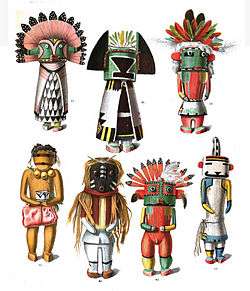

The name Hopi is a shortened form of their autonym, Hopituh Shi-nu-mu ("The Peaceful People" or "Peaceful Little Ones").[2] The Hopi Dictionary[3] gives the primary meaning of the word "Hopi" as: "behaving one, one who is mannered, civilized, peaceable, polite, who adheres to the Hopi way." In the past, Hopi sometimes used the term "Hopi" and its cognates to refer to the Pueblo peoples in general, in contrast to other, more warlike tribes.[4]
Hopi is a concept deeply rooted in the culture's religion, spirituality, and its view of morality and ethics. To be Hopi is to strive toward this concept, which involves a state of total reverence and respect for all things, to be at peace with these things, and to live in accordance with the instructions of Maasaw, the Creator or Caretaker of Earth. The Hopi observe their traditional ceremonies for the benefit of the entire world.
Traditionally, Hopi are organized into matrilineal clans. When a man marries, the children from the relationship are members of his wife's clan. These clan organizations extend across all villages. Children are named by the women of the father's clan. On the twentieth day of a baby's life, the women of the paternal clan gather, each woman bringing a name and a gift for the child. In some cases where many relatives would attend, a child could be given over forty names, for example. The child's parents generally decide the name to be used from these names. Current practice is to either use a non-Hopi or English name or the parent's chosen Hopi name. A person may also change the name upon initiation into one of the religious societies, such as the Kachina society, or with a major life event.
The Hopi practice a complete cycle of traditional ceremonies although not all villages retain or had the complete ceremonial cycle. These ceremonies take place according to the lunar calendar and are observed in each of the Hopi villages. Like other Native American groups, the Hopi have been influenced by Christianity and the missionary work of several Christian denominations. Few have converted enough to Christianity to drop their traditional religious practices.
Traditionally the Hopi are highly skilled micro or subsistence farmers. The Hopi also are part of the wider cash economy; a significant number of Hopi have mainstream jobs; others earn a living by creating high-quality Hopi art, notably the carving of Kachina dolls, the expert crafting of earthenware ceramics, and the design and production of fine jewelry, especially sterling silver.
The Hopi collect and dry a native perennial plant called Thelesperma megapotamicum, known by the common name Hopi tea, and use it to make an herbal tea, as a medicinal remedy and as a yellow dye.[31]
Albinism
The Hopi have a high rate of albinism—about 1 in 200 individuals.[32]
Notable Hopi people
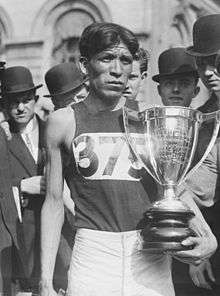
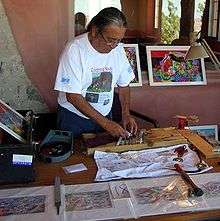
- Thomas Banyacya (born circa 1909 - 1999), Interpreter and spokesman for Hopi leaders
- Neil David Sr (born 1944), painter, illustrator, and kachina doll carver
- Jean Fredericks (born 1906–?), Hopi photographer and former Tribal Council chairman[33][34]
- Diane Humetewa (born 1964), Appointed by President Obama to be a U.S. District Court Judge
- Fred Kabotie (circa 1900–1986), painter and silversmith
- Michael Kabotie (1942–2009), painter, sculptor, and silversmith
- Charles Loloma (1912–1991), jeweler, ceramic artist, and educator
- Linda Lomahaftewa, (born 1947) printmaker, painter, and educator
- Helen Naha (1922–1993) potter
- Tyra Naha, potter
- Dan Namingha, (born 1950), Hopi-Tewa painter and sculptor
- Elva Nampeyo, potter
- Fannie Nampeyo, potter
- Iris Nampeyo (Nampeyo) (circa 1860–1942), potter
- Lori Piestewa (1979–2003), US Army Quartermaster Corps soldier killed in Iraq War
- Dextra Quotskuyva (born 1928), potter
- Emory Sekaquaptewa (1928–2007), Hopi leader, linguist, lexicon maker, commissioned officer of US Army (West Point graduate), jeweler, silversmith
- Phillip Sekaquaptewa (born 1956), jeweler, silversmith (nephew of Emory)
- Don C. Talayesva (born 1890–?), autobiographer and traditionalist
- Lewis Tewanima (1888–1969), Olympic distance runner and silver medalist
- Tuvi (Chief Tuba) (circa 1810–1887), first Hopi convert to Mormonism after whom Tuba City, Arizona, was named
Hopi photographs
 Hopi Women's Dance, 1879, Oraibi, Arizona, photo by John K. Hillers
Hopi Women's Dance, 1879, Oraibi, Arizona, photo by John K. Hillers
 Traditional Hopi Village of Walpi, c. 1920
Traditional Hopi Village of Walpi, c. 1920 Traditional Hopi Homes, c. 1906, photo by Edward S. Curtis
Traditional Hopi Homes, c. 1906, photo by Edward S. Curtis Hopi Basket Weaver c. 1900, photo by Henry Peabody
Hopi Basket Weaver c. 1900, photo by Henry Peabody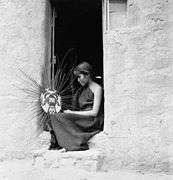 Hopi Basket Weaver
Hopi Basket Weaver Hopi girl, photo by Edward S. Curtis
Hopi girl, photo by Edward S. Curtis Iris Nampeyo, world famous Hopi ceramist, with her work, c. 1900, photo by Henry Peabody
Iris Nampeyo, world famous Hopi ceramist, with her work, c. 1900, photo by Henry Peabody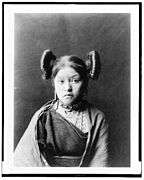 Hopi girl at Walpi, c. 1900, with "squash blossom" hairdo indicative of her eligibility for courtship
Hopi girl at Walpi, c. 1900, with "squash blossom" hairdo indicative of her eligibility for courtship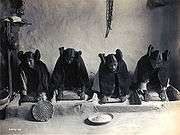 Four young Hopi Indian women grinding grain, c. 1906, photo by Edward S. Curtis
Four young Hopi Indian women grinding grain, c. 1906, photo by Edward S. Curtis Hopi woman dressing hair of unmarried girl, c. 1900, photo by Henry Peabody
Hopi woman dressing hair of unmarried girl, c. 1900, photo by Henry Peabody Children with chopper bicycle, Hopi Reservation, 1970
Children with chopper bicycle, Hopi Reservation, 1970 Hopi girl, 1922, photo by Edward S. Curtis
Hopi girl, 1922, photo by Edward S. Curtis Hopi woman, 1922, photo by Edward S. Curtis
Hopi woman, 1922, photo by Edward S. Curtis Hopi Girls, 1922, photo by Edward S. Curtis
Hopi Girls, 1922, photo by Edward S. Curtis
See also
Notes
- 1 2 United States Census Bureau
- 1 2 "Hopi". Ausbcomp.com. Retrieved 2013-02-17.
- 1 2 The Hopi Dictionary Project, Bureau of Applied Research in Anthropology, University of Arizona (1998), Hopi Dictionary / Hopìikwa Lavàytutuveni: A Hopi-English Dictionary of the Third Mesa Dialect, Tucson: Univ. of Arizona Pr., pp. 99–100, ISBN 0-8165-1789-4
- 1 2 Connelly, John C., "Hopi Social Organization." In Alonso Ortiz, vol. ed., Southwest, vol. 9, in William C. Sturtevant, gnl. ed., Handbook of North American Indians, Washington, D.C.: Smithsonian Institution, 1979: 539–53, p. 551
- 1 2 3 4 5 6 7 8 9 10 Whiteley, Peter M. Deliberate Acts, Tucson, AZ: The University of Arizona Press, 1988: 14–86.
- 1 2 Justin B. Richland, Arguing With Tradition, (University of Chicago Press, 2004) 35.
- ↑ "Short History of Big Mountain – Black Mesa".
- ↑ "Navajo – Hopi Long Land Dispute".
- ↑ "The Navajo-Hopi Land Issue: A Chronology". Archived from the original on 2008-05-30.
- 1 2 3 4 5 6 Brew, J.O. "Hopi Prehistory and History to 1850." In Alonso Ortiz, vol. ed., Southwest, vol. 9, in William C. Sturtevant, gnl. ed., Handbook of North American Indians, Washington, D.C.: Smithsonian Institution, 1979: 514–523.
- 1 2 3 4 Clemmer, Richard O. Roads in the Sky, Boulder, Colorado.: Westview Press, Inc., 1995: 30–90.
- 1 2 3 4 5 6 7 Dockstader, Frederick J. "Hopi History, 1850–1940." In Alonso Ortiz, vol. ed., Southwest, vol. 9, in William C. Sturtevant, gnl. ed., Handbook of North American Indians. Washington, D.C.: Smithsonian Institution, 1979: 524–532.
- ↑ Pecina, Ron and Pecina, Bob. Neil David's Hopi World. Schiffer Publishing Ltd., 2011. ISBN 978-0-7643-3808-3
- ↑ Adams, David Wallace. "Schooling the Hopi: Federal Indian Policy Writ Small, 1887–1917", The Pacific Historical Review, Vol. 48, No. 3. University of California Press, (1979): 335–356.
- 1 2 Johansson, S. Ryan., and Preston, S.H. "Tribal Demography: The Hopi and Navaho Populations as Seen through Manuscripts from the 1900 U.S Census", Social Science History, Vol. 3, No. 1. Duke University Press, (1978): 1–33.
- ↑ United States Congress, Senate, Committee on Interior and Insular Affairs. Navajo-Hopi Land Dispute: Hearing before the Committee on Interior and Insular Affairs, 1974, Washington DC: U.S Government Printing Office, (1974): 1–3.
- 1 2 Hopi Education Endowment Fund. Accessed: November 13, 2009.
- ↑ "Constitution of the Hopi Tribe", National Tribal Justice Resource Center's Tribal Codes and Constitutions. November 28, 2009.
- 1 2 Hopi Cultural Preservation Office. http://www.nau.edu/~hcpo-p/. November 12, 2009.
- ↑ Clemmer, Richard O. "Hopi History, 1940–1974." In Alonso Ortiz, vol. ed., Southwest, vol. 9, in William C. Sturtevant, gen. ed., Handbook of North American Indians. Washington, D.C.: Smithsonian Institution, 1979: 533–538.
- 1 2 3 "Tribal Government". The Hopi Tribe.
- ↑ In The Matter of Village Authority To Remove Tribal Council Representatives, Hopi Appellate Court, Appellate Court Case No. 2008-AP 0001
- ↑ http://www.hopi-nsn.gov/wp-content/uploads/2013/05/Hopi-Code.pdf
- ↑ Berry, Carol (14 January 2009). "Coal permit expansion approved as Hopi chairman resigns". Indiancountrytoday.com. Retrieved 14 November 2010.
- ↑ Berry, Carol (13 January 2010). "Hopi Tribal Council's new structure irks some critics". Indiancountrytoday.com. Retrieved 14 November 2010.
- ↑ May, Tina (6 January 2010). "Hopi Economic Development Corp. Transition Team Off to a Fast Start". Hopi-nsn.gov. Retrieved 14 November 2010.
- ↑ "New Hopi Hotel near Tuba City is Now Open!". Experiencehopi.com. Retrieved 14 November 2010.
- ↑ Fonseca, Felicia. (9 December 2009). "Hopi hotel showcases Arizona tribe's culture". Indiancountrytoday.com. Retrieved 14 November 2010.
- ↑ "Tuvvi Travel Center". Experiencehopi.com. Retrieved 14 November 2010.
- ↑ Helms, Kathy (20 May 2004). "Hopi again vote down gambling". Gallup Independent. Retrieved 14 November 2010.
- ↑ "Medicinal Plants of the Southwest Thelesperma megapotamicum". New Mexico State University. Retrieved 26 February 2014.
- ↑ Hedrick, Philip (June 2003). "Hopi Indians, "cultural" selection, and albinism". American Journal of Physical Anthropology. 121 (2): 151–156. doi:10.1002/ajpa.10180.
- ↑ Masayesva, Victor. Hopi Photographers, Hopi Images. Tucson, AZ: Sun Tracks & University of Arizona Press, 1983: 42. ISBN 978-0-8165-0809-9.
- ↑ Hoxie, Frederick. Encyclopedia of North American Indians. Boston, MA: Houghton Mifflin Company, 1996: 480. ISBN 978-0-395-66921-1
References
- Adams, David Wallace. "Schooling the Hopi: Federal Indian Policy Writ Small, 1887–1917." The Pacific Historical Review, Vol. 48, No. 3. University of California Press, (1979): 335–356.
- Brew, J.O. "Hopi Prehistory and History to 1850." In Alonso Ortiz, vol. ed., Southwest, vol. 9, in William C. Sturtevant, gnl. ed., Handbook of North American Indians. Washington, D.C.: Smithsonian Institution, 1979: 514–523.
- Clemmer, Richard O. "Hopi History, 1940–1974." In Alonso Ortiz, vol. ed., Southwest, vol. 9, in William C. Sturtevant, gnl. ed., Handbook of North American Indians. Washington, D.C.: Smithsonian Institution, 1979: 533–538.
- Clemmer, Richard O. "Roads in the Sky." Boulder, Colorado.: Westview Press, Inc., 1995: 30–90.
- "Constitution of the Hopi Tribe. National Tribal Justice Resource Center's Tribal Codes and Constitutions". Tribalresourcecenter.org. November 13, 2009.
- Dockstader, Frederick J. "Hopi History, 1850–1940." In Alonso Ortiz, vol. ed., Southwest, vol. 9, in William C. Sturtevant, gnl. ed., Handbook of North American Indians. Washington, D.C.: Smithsonian Institution, 1979: 524–532.
- "Hopi Cultural Preservation Office". Nau.edu. November 12, 2009.
- "Partners". Hopi Education Endowment Fund. November 13, 2009.
- Johansson, S. Ryan., and Preston, S.H. "Tribal Demography: The Hopi and Navaho Populations as Seen through Manuscripts from the 1900 U.S Census." Social Science History, Vol. 3, No. 1. Duke University Press, (1978): 1–33.
- Pecina, Ron and Pecina, Bob. Neil David's Hopi World. Schiffer Publishing Ltd., 2011. ISBN 978-0-7643-3808-3. 86-89
- U.S Department of State, Navajo-Hopi Land Dispute: Hearing before the Committee on Interior and Insular Affairs, 1974. Washington DC: U.S Government Printing Office, (1974): 1–3.
- Whiteley, Peter M. "Deliberate Acts." Tucson, Arizona: The University of Arizona Press, 1988.: 14–86.
Further reading
- Clemmer, Richard O. "Roads in the Sky: The Hopi Indians In A Century of Change". Boulder: Westview Books, 1995.
- Harold Courlander, "Fourth World of the Hopi" University of New Mexico Press, 1987
- "Voice of Indigenous People – Native People Address the United Nations" Edited by Alexander Ewen, Clear Light Publishers, Santa Fe NM, 1994, 176 pages. Thomas Banyacya et al. at the United Nations
- Glenn, Edna; Wunder, John R.; Rollings, Willard Hughes; et al., eds. (2008). Hopi Nation: Essays on Indigenous Art, Culture, History, and Law (Ebook ed.). digitalcommons.unl.edu.
- Harry James, Pages from Hopi History University of Arizona Press, 1974
- Susanne and Jake Page, Hopi, Abradale Press, Harry N. Abrams, 1994, illustrated oversize hardcover, 230 pages, ISBN 0-8109-8127-0, 1982 edition, ISBN 0-8109-1082-9
- Alph Secakuku, "Hopi Kachina Tradition: Following the Sun and Moon" 1995
- Alfonso Ortiz, ed. Handbook of North American Indians, vol. 9, Southwest. Washington: Smithsonian Institution, 1979. ISBN 0-16-004577-0.
- New York Times article, "Reggae Rhythms Speak to an Insular Tribe" by Bruce Weber, September 19, 1999
- Pecina, Ron and Pecina, Bob. Neil David's Hopi World. Schiffer Publishing Ltd., 2011. ISBN 978-0-7643-3808-3
- Frank Waters, The Book of the Hopi. Penguin (Non-Classics), (June 30, 1977), ISBN 0-14-004527-9
- Frank Waters, Masked Gods:Navaho & Pueblo Ceremonialism, Swallow Press, 1950; Ohio University Press, 1984, ISBN 0-8040-0641-5
- James F. Brooks, Mesa of Sorrows: A History of the Awat'ovi Massacre, W.W. Norton & Company, 2016; ISBN 9780393061253
External links
| Wikimedia Commons has media related to Hopi. |
- Official website
- A Summary of Hopi Native American History
- Four Corners Postcard: General information on Hopi, by LM Smith
- The Unwritten Literature of the Hopi, by Hattie Greene Lockett at Project Gutenberg
 Herbermann, Charles, ed. (1913). "Hopi Indians". Catholic Encyclopedia. New York: Robert Appleton Company.
Herbermann, Charles, ed. (1913). "Hopi Indians". Catholic Encyclopedia. New York: Robert Appleton Company.- Frank Waters Foundation
- Sikyatki (ancestral Hopi) pottery
- Hopi Cultural Preservation Office
Hopi movie "Techqua Ikachi" part 1 https://www.youtube.com/watch?v=vGdbpu1_STM
Hopi movie "Techqua Ikachi" part 2 https://www.youtube.com/watch?v=XSSHnbjfBl4